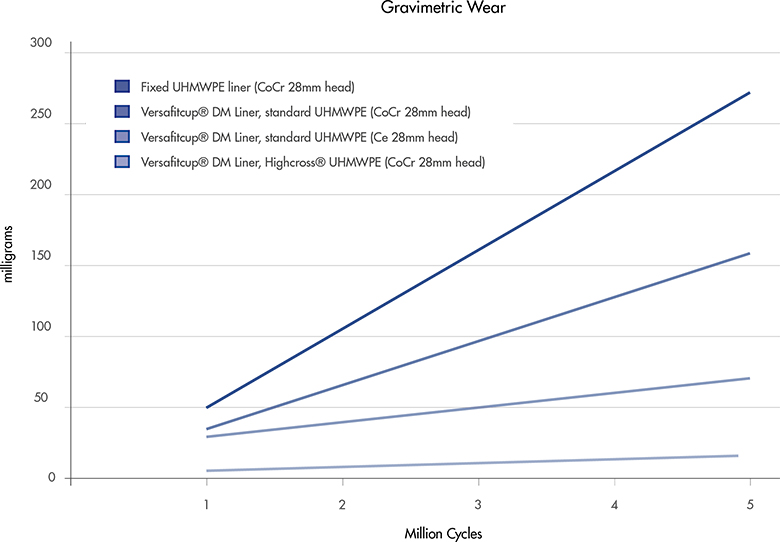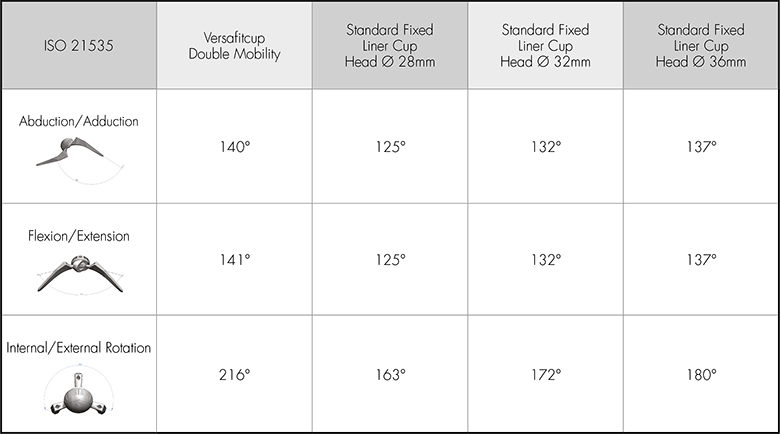
The Versafitcup Double Mobility is based on the original Dual Mobility design developed by Prof. Bousquet and the Medical School of St. Etienne, France, back in 1976.With more than 30 years of successful clinical history this concept is widely used in Europe and in particular in France, where it represents about 25% of the primary hip cup market. With the introduction of the Highcross Double Mobility liner, the Versafitcup can be considered a valid alternative to hard/hard big head articulation.
.png)
WHY CHOOSE A DOUBLE MOBILITY CUP?
Better than standard fixed liner cups:
Low wear rate thanks to the Dual Mobility and Third Articulation.
Low dislocation rate thanks to increased head diameter.
High Range of Motion (ROM) thanks to increased head/neck ratio.
The question of a potential UHMWPE wear increase due to the double articulation has been raised, and clinical follow up from more than 30 years on similar systems has been reassuring. Additionally the dynamic mechanism of action is becoming more understood.
The Dual Mobility and Third Articulation concepts are responsible for the low wear rate of the Versafitcup Double Mobility:

Head/Liner Articulation (80% of the time)
A1 is always smaller than A2 and under physiological loading conditions, A1 is the first to be mobilized up to contact of stem neck with UHMWPE liner rim.

Liner/Shell Articulation (20% of the time)
Only when the stem neck enters into contact with the rim of the liner, A2 starts to move. The rim of the liner is chamfered to articulate with polished neck (Third Articulation concept). This happens with activities requiring high ROM such as climbing stairs.
Thanks to this concept, the wear rate of the Versafitcup is lower compared with standard fixed UHMWPE liner coupled with metal head as shown in the graph below.
By using a Ceramic head instead of a Cobalt Chrome head, the wear rate further decreases by approximately 50% [9]. It is important to always couple the Versafitcup Double Mobility with Medacta femoral stems which have a highly polished neck and a short taper design.

Test on Versafitcup Double Mobility size 64 mm, CoCr 28 mm head, 5 Million Cycles with 3400 N according to ISO 14242-1. Other data are an extrapolation from literature[9] and the above mentioned test.
VERSAFITCUP HIGHCROSS DOUBLE MOBILITY LINER
The Versafitcup Double Mobility design provides a low wear rate. The usage of Highcross, cross-linked polyethylene by Medacta, guarantees a further drastic reduction of wear production, thanks to the enhanced properties. In fact, by using Highcross UHMWPE, the wear rate further decreases more than fifteen times in comparison to a conventional UHMWPE double mobility liner.[10]
This means that the Double Mobility Highcross Liner has wear characteristics comparable to Metal-on-Metal and Ceramic-on-Ceramic bearing combinations.

HIGHCROSS by Medacta is characterised by:
irradiation at 100 kGy,
stabilisation temperature of 150°C,
controlled cooling rate in order to optimise mechanical properties,
final sterilisation with ethylene oxide.
Such innovative production characteristics yield a high quality material with enhanced properties.
It has been demonstrated that for Metal-on-Metal bearing, the prosthesis components positioning is very critical and a bad positioning can lead to early failures due to excessive metal debris.[11,12] Also in the case of Ceramic-on-Ceramic bearing, the implants positioning is really critical, in fact a malpositioning can augment the risk of liner fracture or squeaking.[13] The Versafitcup Double Mobility eliminates all these issues, adding the best protection against dislocation, which is the most common cause of Total Hip Arthroplasty revision, according to a recent market survey. [14]
When the Versafitcup Double Mobility is implanted, the liner diameter provides the hip joint stability, not the head diameter.

Diameter responsible for hip stability is the Head Diameter (28mm, 32mm, 36mm,…).

Diameter responsible for hip stability is the Liner Diameter (38mm, 40mm, 42mm,…), due to the retentive mechanism for the femoral head.
In the Versafitcup product range, the minimal diameter of the liner is 38mm for the 46mm cup and increases with 2 mm steps up to 56mm for the 64mm cup. (Liners can be coupled with 28 mm head for acetabular shells from sizes 48 mm to 64 mm; 22 mm head coupling available for shell sizes 46 mm and 48 mm).

Thanks to that concept, the clinical results reported in the literature on similar product systems show extremely low dislocation rates as low as 0.1% with over 1000 patients enrolled.[4,5,6,7]
In the following table the ROM of the Versafitcup Double Mobility is compared with a standard fixed liner cup size 64mm with different head sizes
(28mm, 32mm, 36mm).

Thanks to the Dual Mobility concept, the Versafitcup has a Head/Neck ratio close to 3.25 for the smallest size growing up to 4.80 for the biggest size: that explains the high Range of Motion of the Versafitcup Double Mobility.
THE DUAL MOBILITY CONCEPT: 30 YEARS OF EXCELLENT CLINICAL RESULTS
Prosthetic articulating systems with two distinct articulating surfaces, so called Dual Mobility systems, were conceived with the aim of:
This Concept had been first proposed by Prof. Gilles Bousquet in 1976.
The basic idea is to couple two concepts: decrease wear according to the low friction concept of Charnley and achieve an intrinsic stability of the articulation utilizing a femoral head of bigger size, more similar to patient’s anatomy as advocated by McKee-Farrar.
The Bousquet concept consist of two interfaces articulating a metallic head (usually of diameter 22.2 mm or 28 mm) with a UHMWPE liner, the latter also articulating with a polished inner surface of the metallic acetabular shell.
Hence the system is basically composed of a press-fit acetabular shell realizing two distinct concentric articulations:
The UHMWPE liner represents, according to the different sizes, approximately 5/8 of a sphere and it is invariably designed with a retentive mechanism for the femoral head.
Stress reduction has been observed and documented over the years and at least three publications of Aubriot et al. [1], Farizon et al. [2] and Leclercq et al. [3] have been dealing with this issue. Altogether more than 380 patients have been followed up for a period of more than 10 years. Results were excellent with an implant’s survival curve exceeding 95%. Even in those cases where a mobilization of the implant led to revision, this was never in association with loss of bone stock suggesting an optimal distribution of stresses.
Several other authors have been addressing the issue of implant stability, early dislocation in relation to a double mobility or bi-articular cup. [4, 5, 6, 7]
Early dislocation remains the main complication after total hip replacement surgery, and its origin is most often multifactorial including surgical mistakes, errors in orientation or lateralisation of the implants, length of the limb, muscular insufficiency, lever effect, neurological disturbances, etc. In the above mentioned literature review, patients with recidivant dislocation or at high risk of dislocation have been satisfactorily treated with this kind of implant.
In terms of safety Leclercq et al. [6] complains of only 1 dislocation on 1100 implants over a periods of more than 10 years.
In the Versafitcup Double Mobility product range, the minimal diameter of the liner is 38mm for the 46mm cup and increases with 2 mm steps up to 56mm for the 64mm cup. (Liners can be coupled with 28 mm head for acetabular shells from sizes 48 mm to 64 mm; 22 mm head coupling available for shell sizes 46 mm and 48 mm).


The Versafitcup elliptical press-fit cup geometry with equatorial macrostructure and surface effect provides a gradual load transfer avoiding peaks and ensuring excellent primary stability. Secondary cup fixation is provided by a dual coating of 100µm plasma spray Titanium and 90µm of Hydroxyapatite.

The equatorial macrostructures shows circular retaining splines which increase the contact between the implant and the bone by 30 to 40%, promoting excellent bone ongrowth.

An upper edge in the shape of a 5° bill provides an additional cover for the articulating liner.

Solid high nitrogen stainless steel cup, interior mirror polishing, without screw holes. Mechanical stable fixation mechanism for precise cup impaction.
The anterior approach, strengthened by several years of clinical experience, is the only technique which follows a path both intermuscular and internervous and therefore reduces considerably the risk of damaging periarticular structures such as muscles, tendons, vessels and nerves.
Thanks to its expertise, unique in the market, Medacta International is the worldwide leader for AMIS (Anterior Minimally Invasive Surgery) with worldwide learning centers to teach the surgical approach, permanent support for surgeons starting with AMIS and continuous development of specific AMIS instrumentation.
With the use of Versafitcup DM you can enter the Medacta International AMIS world.
Discover:


Versafitcup Double Mobility is the valid alternative to Ceramic-on-Ceramic and Metal-on-Metal Large Heads, thanks to its advantages:
The Versafitcup Double Mobility forms part of the Versafitcup system, a complete system of elliptical press-fit cups that shares the same instrumentation.
The system includes the Versafitcup CC Trio, a press-fit cup with lateral screw holes offering the possibility to increase fixation with flat head cancellous bone screws. The Versafitcup CC Trio inner shell has been designed to allow the use of larger heads to better meet the needs of patients and surgeons and better restore biomechanics.
[1] J.H. Aubriot, P. Lesimple, S. Leclercq, Study on cementless Bousquet type cup in one hundred hybrid total hip replacement (femoral stem cemented Charnley type) Average follow-up 5 years. Acta Orthopaedica Belgica, Vol 59 Suppl.I.-1993, Service de Chirurgie Orthopédique et Traumatologique, CHR Côte de Nacre, Caen, France.
[2] F. Farizon, R. de Lavison et al, Results with a cementless alumina coated cup with a dual mobility, a twelve years follow-up study. Int Orthop. 1998; 22(4): 219-224.
[3] S. Leclercq, P. Lemaréchal, D. Richter, J. Aubriot, Charnley-Kerboull-Bousquet hybrid THR after 10 years, Charnley 2000 Total Hip Arthroplasty, 3rd International Symposium, Lyon, France.
[4] J. Debeyre, Dislocation of cemented total hip replacement, Revue de Chirurgie Orthopédique, 1975, 61, 39-42.
[5] S. André, P. Feuillhade De Chauvin, F. Tiberi, M. Postel, Dislocation of Charnely type and Charnley modified Kerboull type Total Hip Replacement, Revue de Chirurgie Orthopédique, 1983, 69, 447-453.
[6] S. Leclercq, S. El Blidi, J.H. Aubriot, Treatment of recurrent dislocation of Total Hip Replacement using Bousquet type double mobility cup. Review of 13 cases, Revue de Chirurgie Orthopédique, 81, 389-394, Service de Chirurgie Orthopédique et Traumatologique, CHR Côte de Nacre, Caen, France.
[7] S. Leclercq, P. Lemaréchal, F. Menguy, J. H. Aubriot, Treatment of recurrent dislocation of Total Hip Replacement using Bousquet type double mobility cup, Literature overview. 74ème réunion annuelle de la SOFCOT, Revue de Chirurgie Orthopédique Novembre 1999, Vol 85, Suppl III, Service de Chirurgie Orthopédique et Traumatologique, CHR Côte de Nacre, Caen, France.
[8] Data on file Medacta.
[9] The Fourth Generation of Ceramics, Ceramtec AG, Germany.
[10] F.Siccardi, I.Quagliana, M.Bernardoni, E.Spadini, M.Zimmermann, Analysis of Versafitcup Double Mobility Wear Rates, Medacta White Paper, January 2010.
[11] R. Trace, Soft tissue reactions to metal-on-metal hip arthroplasty are due mostly to surface wear, Orthopaedics Today Europe 2009; 12:6
[12] D. J. Langton, S. S. Jameson, T. J. Joyce, N. J. Hallab, S. Natu, A. V. F. Nargol, Early failure of metal-on-metal bearings in hip resurfacing and large-diameter total hip replacement, J Bone Joint Surg [Br] 2010; 92-B:38-46
[13] S. Affatato, F. Traina,C. Mazzega-Fabbro, V.Sergo, M. Viceconti, Is ceramic-on-ceramic squeaking phenomenon reproducible in vitro? A long-term simulator study under severe conditions, J Biomed Mater Res B Appl Biomater. 2009 Oct;91(1):264-71.
[14] K.J. Bozic, The increasing number of THA revisions in the United States: Why is it happening?, Orthopaedics Today Europe 2009; 29:6
[15] A.S. Greenwald, J.P. Garino. Alternative bearing surfaces: the good, the bad, and the ugly. J Bone Joint Surg 83-A, Suppl 2 Pt 2: 68-72, 2001.